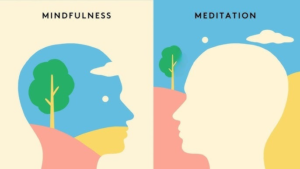For ages, people from many cultures have engaged in mindfulness and meditation, which have been shown to have significant positive effects on mental, physical, and emotional health. These techniques are becoming more well-known for their capacity to assist people in managing stress, enhancing concentration, and leading more balanced lifestyles in the fast-paced world of today. The advantages of mindfulness and meditation will be discussed in this tutorial, along with helpful advice on how to apply them to your everyday life.

What Is Mindfulness?
Being completely present in the moment, cognizant of your thoughts, feelings, and environment without passing judgement, is the practice of mindfulness. It includes:
- Paying Attention: Keeping the present moment in mind.
- Acceptance: is the ability to observe your events without assigning a positive or negative label.
The ability to practice mindfulness at any time and anywhere makes it a flexible tool for improving day-to-day living.
What Is Meditation?
In order to attain a state of clarity, peace, and increased awareness, meditation is a disciplined activity that focusses the mind. It frequently acts as a starting point for developing awareness. There are several varieties of meditation, such as:
- Concentration meditation involves concentrating on one thing, such your breath or a mantra.
- Mindfulness meditation involves paying attention to thoughts and feelings as they come up.
- Developing compassion and love for oneself and others is the goal of loving-kindness meditation.
- Increasing awareness of various bodily areas is the goal of body scan meditation.

Benefits of Mindfulness and Meditation
Meditation and mindfulness are age-old techniques that are extremely relevant in the fast-paced world of today. These methods, which have their roots in traditions like Buddhism but are accepted by people from many cultures and philosophical systems, center on developing present-moment awareness. Frequent practice has several advantages, ranging from bettering physical health to increasing mental clarity and emotional resilience. Mindfulness and meditation enable people to have more balanced, satisfying lives, whether they are employed as a means of lowering stress, increasing creativity, or fostering inner peace.
There are several varieties of meditation, such as:
- Concentration meditation involves concentrating on one thing, such your breath or a mantra.
- Mindfulness meditation involves paying attention to thoughts and feelings as they come up.
- Developing compassion and love for oneself and others is the goal of loving-kindness meditation.
- Increasing awareness of various bodily areas is the goal of body scan meditation.
1. Stress Mitigation
Stress reduction is one of the most well-established advantages of mindfulness and meditation. Frequent practice fosters calmness and lowers cortisol levels, the hormone linked to stress.
2. Improved Concentration and Focus
By teaching your mind to focus on the here and now, mindfulness enhances your concentration. According to research, meditation can increase grey matter in the parts of the brain linked to memory and learning.
3. Control of Emotions
People who meditate are better able to comprehend and control their emotions. It helps you develop a non-reactive mindset, which allows you to react to difficulties deliberately as opposed to hastily.
4. Improved Physical Wellbeing for Mindfulness and meditation
Reduced blood pressure, better sleep, and strengthened immunity are among the physical advantages. Mindfulness-based exercises like yoga and tai chi can help people become more flexible and strong.
5. Better Connections
Mindfulness can improve communication and strengthen interpersonal relationships by cultivating self-awareness and empathy. In particular, loving-kindness meditation fosters favorable emotions towards oneself and other people.
6. Enhanced Resilience
By increasing mental resilience, mindfulness helps you deal with hardship more calmly. It lessens PTSD, melancholy, and anxiety symptoms.
How to Start Practicing Mindfulness and Meditation
Step 1: Decide on Your Goals
Start by outlining your motivations for engaging in mindfulness or meditation. A well-defined objective will keep you motivated, whether your goal is to lower stress, increase attention, or improve your general well-being.
Step 2: Establish a Special Area
Select a peaceful, cozy space where you may practice without interruptions. Seating options include a chair, mat, or cushion. Make sure the area is tidy and welcoming.
Step 3: Take It Easy
Start with 5- to 10-minute sessions and progressively extend them as you get more at ease. In the beginning, consistency is more crucial than length.
Step 4: Pay Attention to Your Breath for Mindfulness and meditation
A key component of mindfulness and meditation is breath awareness. Observe the rhythm of your breathing, taking note of each inhalation and exhalation.
Step 5: Use guided meditations
Guided meditation programs can offer structure and assistance to those who are new to meditation. To get you started, a lot of websites, videos, and apps provide free materials.
Step 6: Incorporate Mindfulness and Meditation into Everyday Tasks
Formal meditation sessions are not the only way to practice mindfulness. Include it in your day-to-day activities by:
- focusing on your senses when you eat.
- taking a stroll and taking in your surroundings.
- actively listening in discussions.
Step 7: Show yourself patience for Mindfulness and meditation
It takes time to make progress. It’s common for your thoughts to stray or for the practice to initially seem difficult. Return your attention to the here and now with gentleness and without self-criticism.
Overcoming Common Challenges
1. “I Don’t Have Time”
A small amount of time each day can have a significant impact. Include awareness in everyday tasks like driving or cleaning your teeth.
2. “My Mind Won’t Stop Racing”
The mind is prone to wandering. Recognizing when this occurs and returning your focus to your breathing or focal point is the practice.
3. “I Don’t Feel Relaxed”
The goal of mindfulness is to observe and accept whatever comes up, not to reach a certain condition. Over time, relaxation frequently happens on its own.
Integrating Mindfulness and Meditation into Your Lifestyle
- Morning Routine: Take a moment to practice mindful breathing or meditation to begin your day.
- Mindful Breaks: During work or study, take a few minutes to stop, take a deep breath, and regroup.
- Practice Gratitude: At the end of the day, consider your blessings.
Resources to Explore for Mindfulness and meditation

- Books:
- The Miracle of Mindfulness by Thich Nhat Hanh
- Wherever You Go, There You Are by Jon Kabat-Zinn
- Apps:
- Headspace
- Calm
- Insight Timer
- Online Courses:
- Mindfulness-Based Stress Reduction (MBSR)
Conclusion
Meditation and mindfulness can have a profoundly positive impact on your body, mind, and spirit. You can develop more awareness, resilience, and joy in your life by spending a few minutes a day on these techniques. On this path to inner calm and awareness, start small, be patient, and treat yourself with kindness.
For more details follow us up on https://www.instagram.com/
and https://saniyajailink.com/
